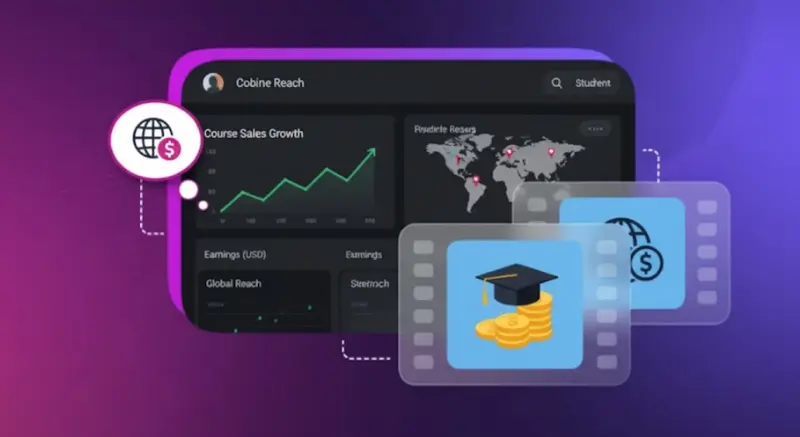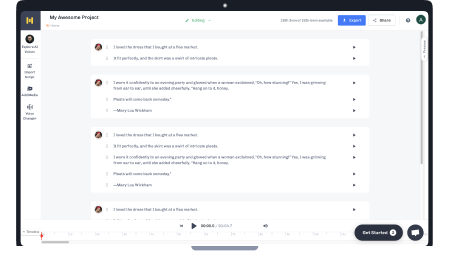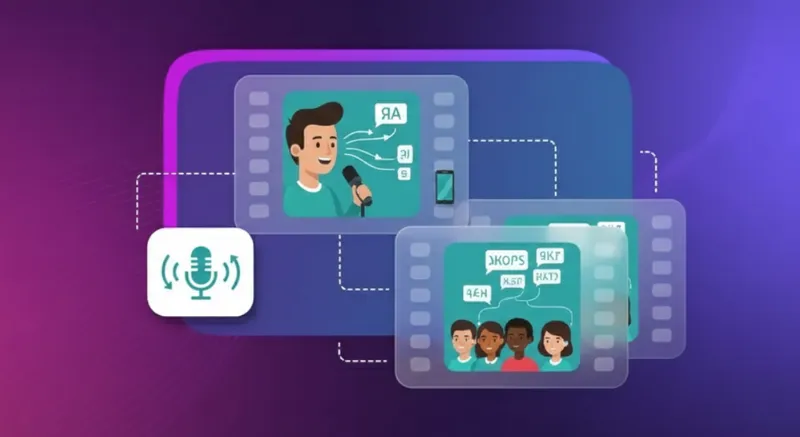How to Sell Your Online Course Globally: The Smartest Side Hustle

Back in the early 2010s, online courses were kind of a curiosity. They were more of a side experiment for teachers and creators who wanted to see if people would actually pay to learn online. Fast forward to 2025, and they’ve become one of the most profitable online side hustles out there.
Picture this: a music teacher in Singapore uploads a few video lessons, builds a simple course landing page, and suddenly has students tuning in from New York, London, and Sydney. That’s the power of digital reach.
The global e-learning market is exploding, from $314.03 billion in 2024, it is expected to grow to $614.87 billion by 2029.
Thanks to AI tools, it’s easier than ever to create online courses, automate marketing efforts, and translate content for global learners.
Excited about building your first course or launching unlimited courses online? This article will suggest tips on how to sell online courses and run a profitable online course business.
Let’s begin.
Step 1: Plan & Validate Your Course Idea
Every profitable online course starts long before you hit Record. The secret isn’t fancy video content or slick sales pages. It’s clarity. You need to know who you’re teaching, what they actually need, and why they’d trust you to help them get there. Too many course creators skip straight to building their dream online school, only to realize halfway through that no one asked for it. Don’t make this mistake. The foundation of your online course creation journey should be research, empathy, and strategy. That’s how you build a business, not just another digital product.
Choose a Topic with Depth and Demand
The best online courses are born where your expertise, passion, and audience demand meet. Use tools like Google Trends, Reddit, Quora, and keyword data to see what’s trending on search engines. Look at what’s missing in free online discussions and free courses.
Also, choosing specific topics spark curiosity and trust. For example, don’t simply teach “marketing.” Teach “social media marketing for new business owners.” The tighter your focus, the stronger your connection with your target audience.
Validate before Final Build
Find out if people would actually buy your course content. Run a short workshop or offer a live webinar. Share polls or stories on social media to test interest. Even better, presell your first course with a simple course landing page.
There’s no need for an all-in-one platform yet. Just measure your form submissions, sign-ups, pre-orders, or just how many people say, “I’d pay for that.”
Define Your Signature Framework & Differentiation
Great courses aren’t just collections of course material. They’re experiences built around a method. Differentiate it from others and make it recognizable with a consistent framework. This will give your course structure and your students get a clear path to progress. And in a world full of online platform noise, that kind of clarity is rare.
Step 2: Build Your Course Content
So, your idea’s solid. Now comes the fun part, i.e., actually producing your course. This is where you take everything you know and shape it into something real. But here’s the thing: creating an online course involves more than just dumping information into videos or slides. You’re building an experience that keeps people interested all the way through.
Pick the Right Formats
Everyone learns differently. Some folks love to binge-watch video content, others want audio files they can listen to in the car. Some subjects come alive with visuals or downloadable files, while others need detailed written guides or live sessions.
Don’t be afraid to mix things up. Use live sessions for interaction, slides to make things clear, and text to drive the points home. You want the learning to feel easy and engaging.
Break It into Modules and Lessons
Think of your course outline as the framework for your whole online school. Each module should build on the last, guiding people step by step. Keep your lessons short and focused while giving learners clear wins so they feel like they’re making progress. Don’t overwhelm them. Good pacing matters. When people see themselves moving forward, they get more confident and stick to it.
Make It Interactive
Learning should be a two-way street. Conduct quizzes, reflection prompts, or group activities to keep everyone involved. If your online course platform has community features, use them. Start real discussions, ask for student feedback, get people talking. These little details make your course feel alive and help students actually learn.
Tools and Software
You don’t need a huge budget to do this well. A decent webcam gets you clean video content, and editing is easy with tools like Descript or Camtasia. Canva can work wonders for visuals, whereas Google Docs and Notion can help you with planning.
Look for an all-in-one platform that lets you upload or import content easily and maybe even handles some marketing automation for you. At the end of the day, it’s not the tools that make a great course creator; it’s your clarity and the way you tell your story.
Step 3: Choose Where & How to Sell
So, you’re done with the hard part: your online course is built and your course material is ready. Now, it’s time to share it with the world. This step is where most creators hesitate, but honestly, it’s just about being smart with where and how you sell. You don’t need a giant audience; you just need the right setup that lets your course sales grow while you stay in control of your brand.
Marketplace vs Owned Site
Marketplaces like Udemy or Skillshare can be a solid way to start. They already have an audience, potential buyers, and built-in marketing tools. You upload your course content, add a few video lessons, and you’re live. The downside? You don’t own the relationship with your students. You’ll compete with free courses, lose a chunk to transaction fees, and have limited say in how your marketing campaign runs.
If you’d rather build something long-term, create your own website or use an all-in-one platform like Thinkific, Teachable, or Kajabi. Here, you get full control over the custom sales pages, affiliate programs, email marketing, custom domains, even membership sites for repeat customers. It’s more work upfront, but you’ll own your traffic, your brand, and your students’ progress.
Top Platforms to Consider
If you’re looking for the best online course platform, here’s a quick breakdown:
- Thinkific: Ideal for beginners who want an all-in-one solution with easy course creation and marketing automation.
- Teachable: Perfect for clean design lovers when it comes to landing pages, one-time payment or subscription options, and flexible marketing tools.
- Kajabi: The powerhouse Kajabi offers live sessions, community features, email marketing, and content marketing tools in one dashboard.
Multi-Channel Approach
Here’s a trick most course creators miss: don’t stick to one channel. Start on a marketplace to build visibility, but gradually shift traffic to your own website or online store. Use paid ads and content marketing to bring in new leads, then nurture them through email marketing and follow up funnels. When done right, this mix helps you reach a broader audience and turn casual learners into loyal fans.
Step 4: Pricing, Packaging & Payment Models
Pricing your online course can feel tricky at first. You want to make it accessible, but you also don’t want to undersell yourself. The truth is, most course creators learn their pricing sweet spot by testing and adjusting over time. The goal isn’t just to make quick course sales, but to build something profitable online that actually lasts.
Pricing Psychology & Models
Think of pricing as storytelling. A one-time payment model works great for shorter digital products or starter courses. Subscriptions, on the other hand, give you stable monthly revenue. If your course is on the pricier side, instalment plans can help potential buyers commit without hesitation.
Experiment by offering coupon codes, or run limited-time promos to see how people respond. The data will tell you what works. And don’t be afraid to charge a higher price if you’re offering more depth in the form of extra live sessions, ongoing support, or community features that add real value that students will pay for.
Upsells, Bundles & Tiered Versions
Don’t stop at one profitable online course. Create additional resources, like cheat sheets, downloadable files, or even short free courses that complement your main program. Bundle a few of your digital products together or design tiered versions: maybe a basic plan for self-learners, and a premium one with personal guidance or additional support.
Upsells work best when they feel natural. Offer them as logical next steps in your students’ journey, not as pushy add-ons. The more value you give, the easier it is to earn repeat customers.
Payment Gateways, Currency, Refund Policy, Compliance
Many creators don’t acknowledge enough that the payment experience matters. If checkout is clunky, people drop off fast. Use reliable payment gateways like Stripe or PayPal, enable global currencies, and clearly state your refund policy. These details may seem boring, but they build trust.
If you’re running unlimited courses or selling globally, check compliance rules related to taxes, GDPR, and so on. It might not be glamorous, but smooth payments and transparency are what make your online school feel professional from day one.

Step 5: Marketing & Launch Strategy
Marketing is all about showing up consistently and connecting with your target audience in ways that feel real.
Pre-Launch Content & Lead Magnets
Before you launch, talk about your course openly by sharing insights, behind-the-scenes clips, or even short video lessons as teasers. Offer free online webinars or downloadable files to build curiosity and gather early interest through form submissions. A simple landing page or course landing page with a lead magnet, like a mini guide or a free course sample, can do wonders.
Launch Funnels & Email Sequences
During launch, map out an email marketing sequence: a few pre-launch emails to build anticipation, then follow-ups to remind people what they’ll gain. Follow up after the launch to turn hesitant prospects into new leads or even repeat customers.
Evergreen vs Cohort Launches
Evergreen courses work beautifully if you want steady, profitable online income year-round. Cohorts, where everyone starts together, build stronger community engagement and accountability. Test both to see which model suits your teaching style and audience best.
Paid Ads, Partnerships, Influencer & Content Marketing
Once you’ve got momentum, start amplifying it. Mix paid ads with social media marketing, collaborations, and influencer partnerships. But remember, authenticity beats fancy graphics every time. Use student feedback and success stories as social proof.
Step 6: Deliver, Support & Retain Students
It's important that you don’t undersell yourself, but keep it real. Pick a price that respects both you and your learners.
Onboarding & Orientation
The first few moments of your course matter more than most people think. That’s when students decide if they’re in the right place. So, make their first steps smooth. And if your course includes a community space, make it easy to find. The goal is to help them settle in fast and feel seen, not lost in a maze of links.
Community & Engagement
Build spaces where your students can connect, whether that’s a private group, Discord server, or even live office hours. Encourage small wins and conversations that don’t just revolve around the course. Drop in sometimes yourself, respond to a comment, and host a casual Q&A. That kind of presence builds loyalty more than any bonus module ever could.
Feedback Loops & Iterative Improvement
What separates great creators from average ones is how they handle feedback. Keep the conversation open, gather feedback about what’s working and what isn’t. Then, use this information to tweak lessons, improve resources, and re-record confusing parts.
Upsell to Advanced Courses or Coaching
Once students reach the end of your course, don’t just wave goodbye. Maybe create and sell a next-level course, a live mentorship, or private coaching going forward. Frame it as the next step in their learning journey, not a sales pitch.
Step 7: Scale, Automate & Optimize for Growth
Get people excited before you even launch. Talk about the curriculum design on your socials, tease what’s coming, maybe share a behind-the-scenes peek. The goal is to make people curious enough to click that “enroll” button without hesitation.
Automation & Integrations
When your course starts growing, you can’t manually handle every little task. Set up systems that do the heavy lifting for you. Automate onboarding emails, reminders, progress updates, and feedback forms. Integrate your LMS with your CRM, payment tools, and analytics so everything runs smoothly behind the scenes.
Scaling via Affiliates, Joint Ventures, Licensing
Sometimes, growth means letting others help you grow. Bring in affiliates, i.e., the people who genuinely believe in your course, and let them share it with their audience. Or collaborate with other creators for joint workshops or bundles. Licensing is another quiet powerhouse: let institutions or coaches use your content under their brand. You’ll be surprised how far your reach can stretch once you stop trying to do everything yourself.
Expanding Course Catalogs or Verticals
If one course does well, don’t stop there. Think of this course as the first chapter in a much bigger story. What do your students naturally want next? Maybe a deeper dive into one specific topic, or a complementary skill that ties it all together. Build new courses around those needs. Over time, you’ll create a connected ecosystem where learners can grow with you, step by step.
Internationalization & Localization
At some point, you’ll hit a new kind of growth wall: language. You might create engaging material and have people from across the world interested in your course, but not everyone learns best in English. That’s where Murf AI’s tools, like Video and Audio Translator, come in handy.
With Murf AI’s free video translator, you can automatically translate your course videos and audio into more than 40 languages. Plus, you get access to 200+ AI-generated voices that allow you to effortlessly modify your voice in real time. The best part? The voiceovers sound natural, with 99.38% pronunciation accuracy. It’s like having your voice speak fluently to students from different corners of the world.
With Murf AI, this simple shift lets you reach new audiences, open new markets, and grow your revenue without having to rebuild your entire course from scratch.

Conclusion
Fortunately, selling online courses isn’t some far-fetched dream anymore. It’s one of the most profitable online side hustles you can start right now. The roadmap is simple: validate your idea, create online courses that genuinely help people, pick the best online course platform for your goals, and promote it using smart marketing tools.
Keep learning from student feedback and improving your course content as you go. You don’t need to have it all figured out on day one. Begin by sharing what you know. Somewhere out there, your target audience is already looking for it.

Frequently Asked Questions
How do I sell an online course if I don’t have an audience yet?
.svg)
It makes sense to start small. Share free tips, run free courses, post on social media, and show what you know. As you build trust, your target audience will grow naturally and they’ll be ready to buy when you do launch.
Which platform is best for selling my online course?
.svg)
There’s no single “best” one. If you want everything under one roof, go for an all-in-one platform like Kajabi offers. If you prefer something simpler, Teachable or Thinkific are great for course creation and course sales with lower transaction fees.
Is it legal to sell courses online?
.svg)
Yes, it’s totally legal to sell courses online. But make sure your course material is original and that your payment gateways and refund policy follow standard rules in your region.
How long does it take to build an online course before selling?
.svg)
It depends on the topic and format. If you plan your course outline early and keep your video lessons short, you can get your first course live in a few weeks. Don’t aim for perfection. Just aim to launch, learn, and improve.
Can I sell my course on multiple platforms simultaneously?
.svg)
Yes, many course creators do. You can list your online courses on marketplaces like Udemy and still promote them on your own website. Just keep your pricing and course landing page consistent across every online platform.















